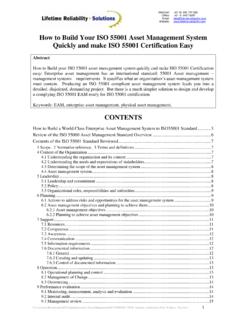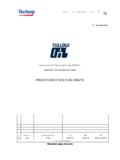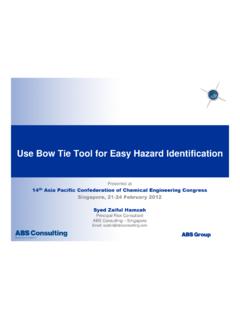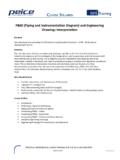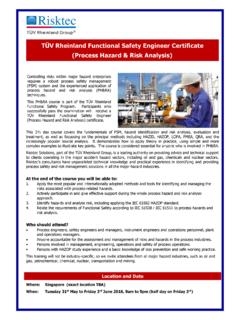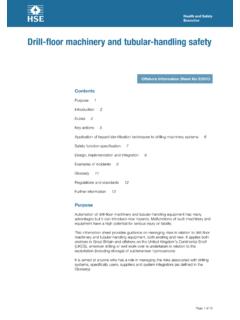Transcription of The Bowtie Methodology
1 The modern, fast and easy to use risk analysis tool The Bowtie Methodology Bowtie Pro Enterprise Business Centre Admiral Court Poynernook Road Aberdeen, AB11 5QX, UK Tel: +44 (0) 1224 51 50 94 Bowtie Methodology +44 (0) 1224 51 50 94 Page: 1 Introduction This Bowtie method of analysis is a qualitative analysis incorporating management system techniques. The Bowtie has become popular as a structured method to assess risk where a quantitive approach is not possible or desirable.
2 The success of the diagram is that it is simple and easy for the non- specialist to understand. The idea is a simple one of combining the cause (fault tree) and the consequence (event tree). When the fault tree is drawn on the left hand side and the event tree is drawn on the right hand side with the hazard drawn as a "knot" in the middle the diagram looks a bit like a Bowtie as shown This method of analysis uses the risk matrix to categorise the various scenarios, and then carries out more detailed analysis (in the form of fault and event trees) on those with the highest risks. The essence is to establish how many safety barriers there are available to prevent, control or mitigate the identified scenarios, and the quality of those barriers.
3 When managing major hazards there are four key objectives of using bowties 1. To give an overview of the framework relating to managing major accident hazards 2. To illustrate the interdependencies between the various stages in the framework 3. To show how the process needs to be applied to any analysis 4. To ensure we all have a common understanding of what we re doing, why and how we re doing it Fault Tree Event Tree Management Systems A Management System can be defined as a structured set of controls for managing the business; to ensure and to demonstrate that business objectives are met. It brings a structure to the policies of the business. No Structure Structure Bowtie Methodology +44 (0) 1224 51 50 94 Page: 2 The management system is a systematic and fit for purpose way of managing risks through personnel, resources and procedures.
4 It is not documentation alone. A successful management system requires the full participation & commitment of everyone involved in facility or operation and a safety culture developed over years not months. Risk Management Process The key to any management system is the risk management process. This process can be simplified to Identify Are people, environment or assets exposed to potential harm? Assess What are the causes and consequences? How likely is loss of control? What is the risk and is it ALARP? Control Can the causes be eliminated? What controls are needed? How effective are the controls? Recover Can the potential consequences or effects be mitigated? What recovery measures are needed?
5 Are recovery capabilities suitable and sufficient? This appears in the Bowtie diagram Where does this fit in the management process Bowtie Methodology +44 (0) 1224 51 50 94 Page: 3 Bowtie Pro s sophisticated yet easy to use approach makes the identification of the posts and further analysis very possible Which risks have to be managed? Any risk that has the potential to cause harm need to be managed. This includes ill health, injury, and damage to property, products or the environment, production losses or increased liabilities.
6 Examples of HSE risks include: Health, Safety and Environmental incidents, o acute intoxication, o large fires and explosions, o major spills on land or water Long term exposure of staff o workplace exposure ( to chemicals, noise, heat) o infections ( food, water, parasites) o ergonomic conditions o psychological conditions ( stress) Long term exposure of the environment o discharges to air, water and soil (waste) o use of resources (ground water, sand, wood) o use of space o socio-economic impact Risk is defined as the Combination of PROBABILITY x CONSEQUENCE. An excellent way of estimating the risk is to use a risk matrix SEVERITY CONSEQUENCES LIKELIHOOD People Asset Environment Reputation 1 2 3 4 5 Very Unlikely Unlikely Possible Likely Very Likely 1 No/ Slight Injury No/ Slight damage No/ Slight effect No/ Slight Impact Low Low Low Low Low 2 Minor Injury Minor damage Minor effect Limited Impact Low Low Low Medium Medium 3 Major Injury Local damage Local effect Major Impact Low Low Medium Medium High 4 Fatality Major damage Major effect Nat.
7 Impact Low Medium Medium High High 5 Multiple fatalities Extensive damage Massive effect Internat. Impact Medium Medium High High High Risk matrixes come in a wide variety of both sizes and types. The matrix above is known as a 6 x 5 and is one of the most commonly used, though matrices may be encountered ranging from 2 x 2 to 10 x 10. The colours in the matrix can be altered but most are in line with the traffic light identification (as shown) but options such as the black swan options can also be implemented The example matrix shown is a reactive matrix which uses historical evidence to provide guidance on the frequency term.
8 The other most frequently encountered type is a predictive matrix, where the frequency terms could be 1 in 10,000 chance of occurring to will occur ten times per year . Bowtie Methodology +44 (0) 1224 51 50 94 Page: 4 The basis of the risk matrix is always, however, the same - matching the frequency and consequence terms. As such it is important that the scoring mechanism used is decided in advance and applied consistently. Where does all this information come from? Although you may not have the information organised, it is very rare that you will not have any information to create your bowties.
9 The information can come from a range of sources. Possible sources of information are shown below: Identify Assess Control Recover Hazards HAZID Checklists Incidents Experience Job Hazard Analysis Threats HAZOP SAFOP FEMA Tripod-D E L T A Process Hazard Review Consequences FirePran Explosion Protection Review Process Hazard Review Codes and practices Job Hazard Analysis Physical effects modelling Environmental Dispersion Modelling Oil Spill Trajectory Modelling Qualitative Risk Assessment Quantitative Risk Assessment Human Exposure to Soil Pollutants (HESP)
10 Codes and practices Procedures Human Factors Engineering Waste management Codes and practices Tripod-B E T A Drills and Exercises It should be emphasised that when moving forward with the Bowtie Methodology use what you have got, DO NOT start again from scratch When managing major risks the Bowtie Methodology gives real advantages as it gives a single integrated overview of issues and solutions providing transparency, connectivity (traceability) and Interactions between cause, effect and control Bowtie Methodology +44 (0) 1224 51 50 94 Page: 5 The Bowtie process The process involves the systematic identification of hazards and effects, assessment of the associated risks and the specification of the control and recovery measures which must be in place and maintained in place.

